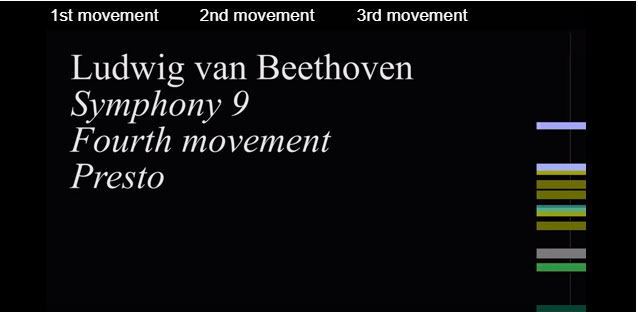Beethoven and his message to our times. (Ludwig Von Beethoven)
Beethoven was not the only tortured artist who composed exquisite
music in the face of his suffering (Gesualdo’s agonies of guilt,
Bach’s loss of 10 of his 20 children in childhood), but his music
is an especially poignant illustration of the human spirit’s
striving to transcend and overcome its pain. He had contemplated
suicide years earlier when his deafness was first overcoming him,
and almost all the most famous and celebrated music you know of
Beethoven came AFTER that. But not easily. Mozart famously wrote
almost effortlessly, as if dictating. For example, Mozart wrote
the Overture to Don Giovanni on the morning of the premier,
writing 41 symphonies in all, though he died in his early 30s.
Beethoven lived almost twice as long, and only wrote 9 symphonies,
and reworked the last one from bits of materials written 10 years
before, writing and rewriting. We know from his notes many
premature scribbles and versions of his 9th Symphony theme, that
were quite underwhelming. He struggled.)
The fourth movement of his last symphony, (amazingly rendered
visually by my friend Stephen Malinowski) is the pinnacle of
perhaps one of the greatest musical careers of the ages. (And I
LOVE Bach, and dozens of others in the pantheon). Amazingly, you
can also whistle it . . .
Beethoven is held in awe as one of the musical “saints”, including
by my mentor and inspiration for Piano Wizard, Don Beattie, whose
love of Beethoven and others inspired me to study music
seriously.
Later, Dr. Robert Winters, one of my professors of the Classical
era style (Mozart, Haydn, Beethoven) at UCLA, once broke this
movement down for our class, and his analysis, shared roughly
below, reveals yet another layer of the genius of it especially if
you know the rest of the piece.
The fourth movement is a re-creation and illustration of his
composing mind. It opens in crisis, then searches for musical
themes, first finding the themes of the first movement, then the
second,, then the third, before rejecting each and lurching into
the next (The human mind first searches its archives, and only
when rejecting those past solutions, does true creativity emerge)
until he stumbles into what turns into his world famous
theme of the Ninth Symphony, first rendered purely as a simple
melody, doubled in the base strings. It then is joined by
the orchestra, and harmonized, enriched, and explored,
(foretelling the message of harmony of Schillers’s Ode to Joy”).
But all of these themes lack something, yes they are vibrant, yes
they speak of suffering, but not . . . Joy. Transcendental joy,
the purifying of our suffering through compassion, solidarity, and
unity of purpose. (and of course, through MUSIC.)
And so the music abruptly is interrupted. A voice, almost as if
from the audience, interrupts. Yet the interruption was also
foretold in the symphonic parts of the music, though it still
shocks.
“Freunde! Nicht diese tonen!”
“Friends! Not these tones. “
And he (Beethoven), breaks with ALL WESTERN MUSIC up to that
point. Nobody sees it coming, many critics of the time thought he
was mad, and found the music deeply disturbing and even ugly and
dissonant.
Up until this symphony, NOBODY had introduced a CHORUS into a
symphony structure, let alone commented on the earlier portion.
This completely startled the audience, and and what he did next,
“broke” the Classical style completely (he had cracked it many a
time), and birthed the richest most passionate, most varied epoch
in classical music, the Romantic Era.. .
He introduces poetry and meaning into his symphonic work, mashing
passionate opera, oratorio and symphony into a strange stew. He
then uses this strange and wonderful poem, to speak of this
“joy”,, to exalt the brotherhood of man (Alle menschen werder
Bruder, All men will be brothers)
Historically, (1824) this was concurrent with class turmoil,
dozens of battles and revolutions across Europe, originally
stimulated by Napoleon and the American revolution, overthrowing
monarchies, the idea of human rights, fruit of the Age of
Enlightenment, of which Beethoven was a fervent admirer, (though
NOT of Napoleon himself).
>From here, the excerpts of the poem that Beethoven chose (the full
poem is much more wandering and even mediocre) he expresses his
urgent message for all of us to leave behind the arbitrary
divisions of convention and culture, and unite our souls, and
receive the “kiss of nature” that must come from a loving father
beyond the starry canopy, beyond the veil, beyond our
understanding, but who must exist. The “joy” that we all feel,
that sparks our souls.
He “reworks” the famous theme, in a fantastic, startling and
ground bursting way, from martial, to sacred, to a dance, to an
urgent imploration, and finally to a celebration, in a series of
climaxes and variations that leave us dizzy and even exhausted
(one of the most challenging choral and vocal pieces in the
classical repertoire even today)
His promise, his request, his invitation remains unfulfilled up to
this day, but in spite of the dramatic set backs in human
evolution (The Nazis famously borrowed his theme for a war song,
talk about blasphemy!), we struggle forward to find that
transcendent harmony amongst ourselves, especially today in our
American life. It is life or death that we as the human race find
it.
Here in this piece is a musical and spiritual map for the soul of mankind to use
to find our way.
I wish you great joy.



